December 1, 2015: Checking the progress of the Bigwala trumpets
Today, we travelled 3 hours from Kampala to Jinja, to the village of Bukakaire, to listen to the Bukakaire Bigwala Players, led by the last surviving trumpeter from the Busoga Kingdom, James Lugolole.
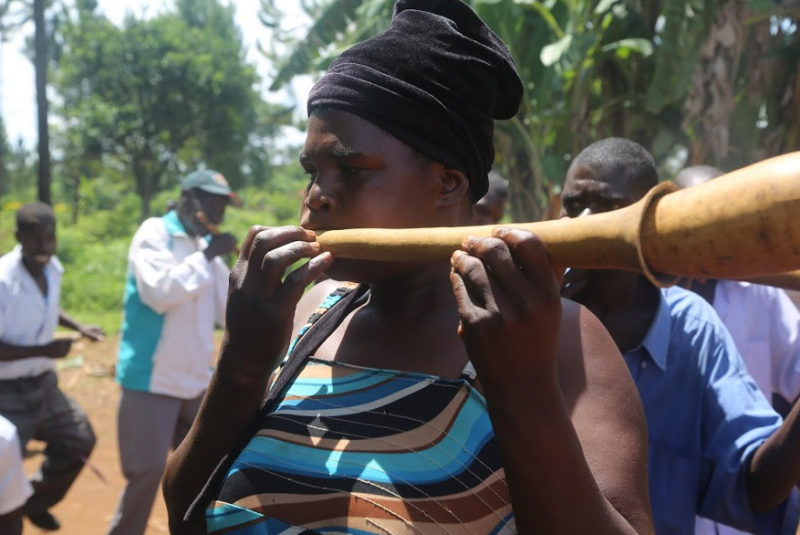
A woman playing the Bigwala
First, why are we here? Well, there’s the obvious: at Singing Wells, we record and share the great music of East African villages. But, there’s another, equally important reason: the revival of the Bigwala trumpets was the model we used for the restoration of the Royal Drums. We felt it was critical to check in on their progress. We focused on three main things on this visit:
- Interviewing James about the instruments themselves
- Recording the trumpeters
- Interviewing James in more detail about his life and work to restore the Bigwala trumpets.
Part One: detail on the instruments
The Bukakaire Bigwala Players are made up of three separate groups of musicians: the trumpets, the drums and the xylophone. Let’s look at each in turn:
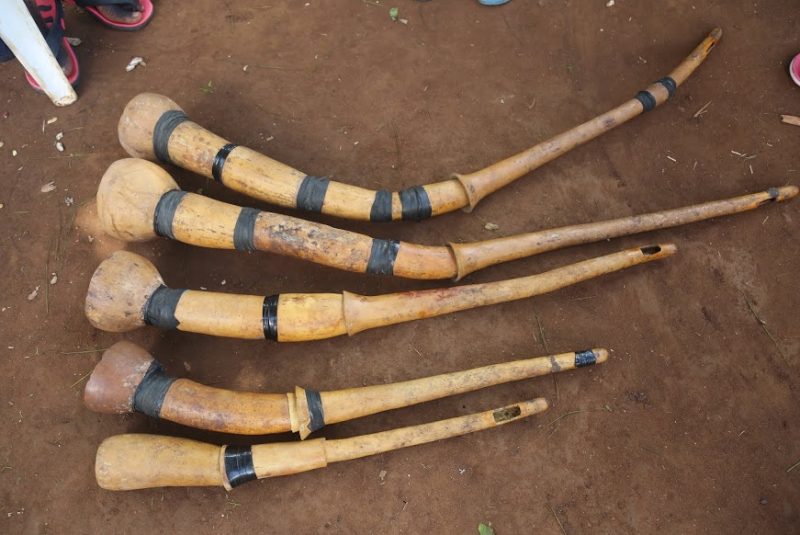
The Bigwala trumpets
These trumpets are made of long gourds and a trumpet group is made up of at least five trumpets (or more), each of which plays a specific role. They are tuned to the pentatonic scale and like the royal drums are often tuned to the xylophone. Our group had five trumpets:
- The Enhana: meaning ‘calf’ — this is the largest trumpet, lowest in pitch and the one tuned initially to the xylophone
- The Empala: meaning ‘leopard’ and tuned one tone up from the Enhana
- Endhasasi: meaning ‘the one in the middle’, or ‘the one that slices the group in half’, the cutter
- The Endeesi: meaning ‘the starter of the song’
- Endumirizi: meaning ‘the loudest of the group’
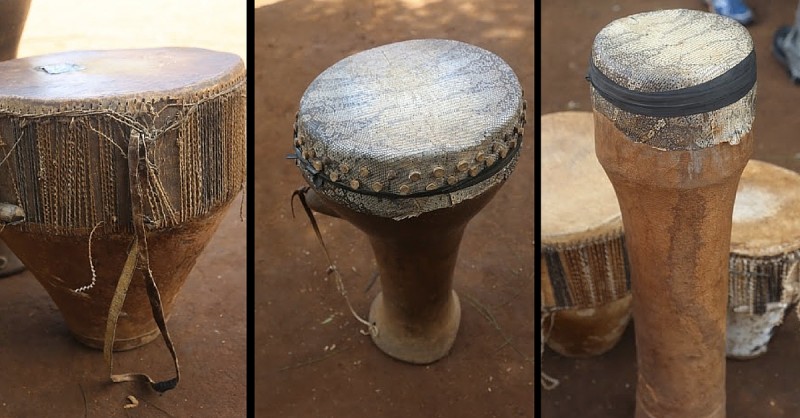
The drums
This group had five drums and they were:
- The Engoma’nene: the big drum
- The Enduumi: the middle drum
- The Ngiringidi: the smaller drum, so named because the name sounds like the drumbeat
- The Engaabe: the long drum with a lizard-skin playing surface
- The Endyaanga Namaganda: the short drum with a lizard-skin playing surface, and the bass drum
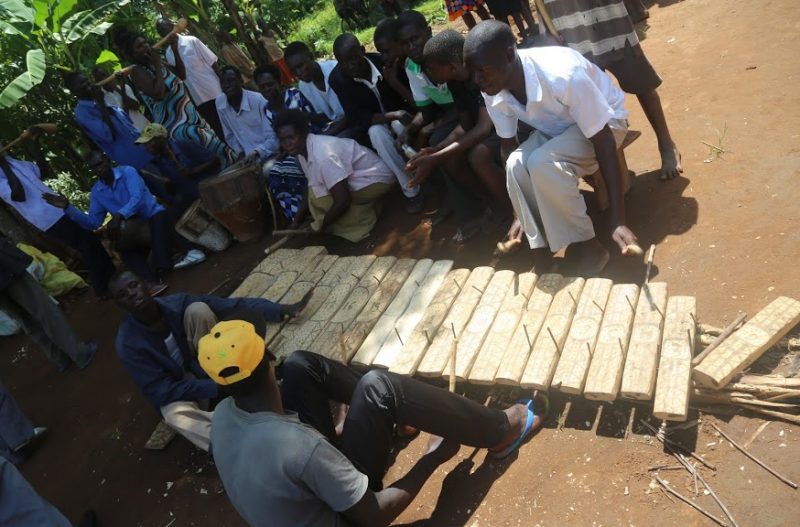
The xylophone
Here, we will focus on the players, verses the xylophone instrument itself. We have recorded a lot of Ugandan xylophones over the years, but this time we really wanted to understand the players themselves as the arrangement mirrors in many ways the royal drums. There are generally six players, 3 on each side, configured very roughly as follows (I say roughly, because the notes each plays depends on the song):
- Akubaa Obuto: meaning player of the small slabs, this musician plays keys 1-4, the highest notes
- Atabula: meaning the mixer, this musician plays keys 5-11
- Asansaga: this person plays keys 8-15
- Ow’enduumi: this person plays 13-15 and means ‘player of the Nduumi’
- Ow’enene: this person plays keys 16-21 and the meaning of his name is literally, the ‘player of the Enene’
- Engaabe: this person solely plays 21. In this group, this musician was fantastic and led the whole group
Part Two: recording the performances
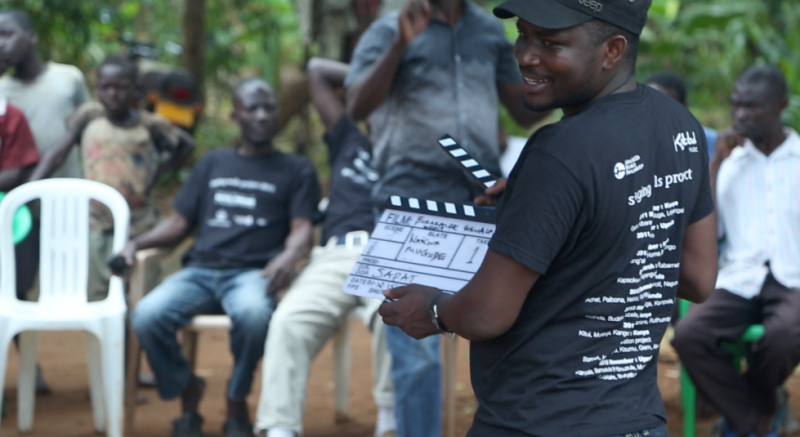
Singing Wells team member Nick with the clapper
Consider the Bigwala like a marching band combined with a king’s processional trumpets, you know the musicians that announce the entry/exit of the sovereign. In our village, then, you had the xylophone players sitting three to a side ready to play their instruments, backed by the drummers. And then marching around them, twirling as they play, are the five trumpeters and, in our case, a dancer, leading them around the stationary drummers and xylophone players. Add a grand quantity of dust, unleashed from the stamping feet of the trumpeters, and sprinkle in a lot of children wanting to join the circling parade, and you get a good sense of the scene. This is a chaotic celebration, not a refined performance of an orchestra. While normally we set up three cameras to record, here we abandoned our tripods and entered into the melee to better capture the moment. So, as we describe songs, think of these as acts of a dusty, wonderful village mosh pit. And in there were three songs:
- Waiswa Mugude: we’ve run into this song before actually and it’s a popular story around this region of Uganda. Essentially the name “Waiswa” means the first-born male twin. But our hero “Waiswa” in this case is impotent. While the song lyrics repeat that when one comes to shake his hand, he pulls his hand away, everyone knows the singers mean he has to run from any ladies’ advances due to some technical problems in the engine room.
- Mughe (more detail to follow)
- Mperekera Omwana Owomulembe (more detail to follow)
Part Three: interview with James Lugolole

Above: James Lugolole
We’ll provide more details of this interview, but for now, a couple of key points:
- James is the last surviving Bigwala player from Busoga. He started there at 12 and his father, grandfather and probably others before were all trumpet players.
- The traditions died as the kingdoms died and he felt the trumpets had gone for good. In fact, the knowledge of how to grow the gourd to make the trumpets was lost and the seeds for the long gourd were almost impossible to find. A tradition literally dying on the proverbial vine.
- James Isabirye found James Lugolole around 2005 and set out to restore the tradition. They formed a new group, which we recorded in 2013, and they re-discovered the gourd seeds and started coordinating farmers to grow the next generation of trumpets.
- There are now four trumpet groups and about 20 trumpets, with many more growing in the fields in different parts of Busoga.
- Everything about the Bigwala model has become the inspiration for our attempts to rediscover the lost royal drums. The trumpets are thriving and young people are starting to learn the instrument again.
- And James Lugolole is thriving. In his interview he told us, “I am so happy. I feel now, when I finally die, I will have a hand that has reached back, teaching others the trumpets so the music lives beyond me.”
